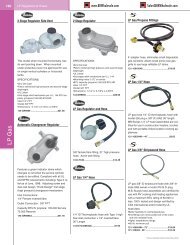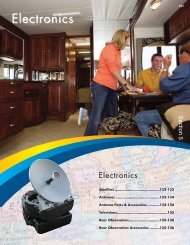Suburban Furnace Service Manual - BR Wholesale RV & Marine
Suburban Furnace Service Manual - BR Wholesale RV & Marine
Suburban Furnace Service Manual - BR Wholesale RV & Marine
You also want an ePaper? Increase the reach of your titles
YUMPU automatically turns print PDFs into web optimized ePapers that Google loves.
SE<strong>RV</strong>ICE HINTS, DIAGNOSIS, AND CORRECTIVE MEASURES<br />
FOR THE IGNITION SYSTEMS OF<br />
SUBURBAN 24 VOLT ELECTRONIC IGNITION GAS FURNACES<br />
WITH TIME DELAY<br />
CAUTIONS:<br />
1. Never operate the furnace with the electrode wire disconnected nor with<br />
the electrode assembly removed from the furnace.<br />
2. Never use a screwdriver on any part of the electrode assembly<br />
while the furnace is in operation.<br />
3. Be certain that the spark from the electrode never reaches the flame<br />
sensor portion of the electrode assembly.<br />
4. Be sure the electrode assembly screws are snug at all times, especially<br />
after the electrode has been removed and reinstalled.<br />
5. If the module board is found to be defective, it must be replaced - it is not<br />
field repairable. Any attempts to repair the board may alter the board and<br />
cause it to operate in an unsatisfactory manner.<br />
6. Insure that the gap between electrode and ground is always 1/8". The<br />
gap between the flame sensor should be approximately twice the gap<br />
between electrode and ground to insure no sparking to sensor. Sparking<br />
to sensor will damage the module board.<br />
The electronic ignition system is made up of three main parts; the module<br />
board, the electrode assembly, and the electrode wire. The module board<br />
is the brain of the electronic ignition system and it has several functions.<br />
1. When the blower reaches approximately 75% of the normal r.p.m.<br />
and sufficient air flow is established, the sail switch engages and completes<br />
a 24 volt circuit through the limit switch to the module board.<br />
2. After a 12 - 18 second delay, 24 volt current will pass through the<br />
module board to the solenoid valve. The current to the valve opens it and<br />
allows gas to the main burner; simultaneously, the module board sends<br />
high voltage through the electrode wire to the electrode assembly. The<br />
voltage seeks a ground between electrode and ground probe and a spark<br />
occurs. The spark then ignites the main burner.<br />
3. The module board also performs the lockout function in cases where the<br />
spark fails to light the burner. When lockout occurs, the spark stops, the<br />
voltage from the module board to the gas valve is discontinued, and the<br />
valve closes. The unit will remain in lockout and the blower will continue to<br />
run until the thermostat is turned off. Turning the thermostat off disengages<br />
the lockout function of the module board. After the blower has stopped, the<br />
ignition sequence can be started again. The module will try three times for<br />
ignition before lockout.<br />
It is important to determine the type problem being experienced, then<br />
the proper checkout procedure can be made. The following is a list of<br />
problems, how to identify in which area the problem is located, and<br />
how to correct it.<br />
1. Electrode not sparking - with blower running and micro switch<br />
engaged, check the following:<br />
a. Check for proper voltage at module board after the blower motor<br />
reaches full r.p.m. If no voltage, check continuity through micro<br />
switch and limit switch. Also check wiring and wire connections.<br />
b. Voltage is present but no spark at electrode after 12 - 18 second<br />
delay, check electrode wire connections.<br />
c. Wire connections OK, but electrode wire does not show<br />
continuity through it - replace electrode wire.<br />
d. Electrode wire does show continuity through it - check electrode<br />
gap to be sure it is 1/8" maximum between electrode and<br />
ground. NOTE: Gap between sensor and ground must be twice<br />
electrode gap.<br />
e. Electrode gap OK - check electrode assembly for possible<br />
cracks or carbon on tip of electrode.<br />
f. Electrode OK - replace module board.<br />
2. Electrode sparking, but gas not coming through burner:<br />
a. Check to see if voltage is coming out of module board to gas<br />
valve after the 12 - 18 second delay. Check the wires in the<br />
molex connector to be sure they are intact and making contact<br />
with the module board. Check wire from the module board to<br />
valve for continuity. Wire and connections check OK - replace<br />
module board.<br />
b. Voltage is coming out of module board to gas valve, but gas<br />
valve does not open - replace gas valve.<br />
3. Electrode sparking and gas valve opening, but burner will not<br />
light:<br />
a. Check to see if gas is coming through to the burner. This can be<br />
accomplished by using a flow meter in the gas supply line. If no<br />
gas is coming through the burner, check for obstruction in gas<br />
line, in main burner orifice, or in main burner.<br />
b. Gas is coming through burner, but spark will still not ignite<br />
burner - check gas pressure.<br />
Line Pressure - Min. 11" W.C.*, Max. 14" W.C.<br />
To properly check pressure, first determine the line pressure, cycle<br />
furnace and check pressure drop on demand. The drop in pressure<br />
should not be more than ½" W.C. A drop of more than 1/2" would<br />
indicate a faulty regulator, a restriction in the gas line, or a pinched gas<br />
line. Excessive pressure drop could also be due to moisture<br />
contamination.<br />
c. Gas pressure OK - check for obstruction in main burner;<br />
check to be sure electrode is positioned approximately 1/4"<br />
above and directly over slots on the main burner - adjust<br />
electrode if necessary.<br />
d. Remove burner and check burner for obstructions. Clean as<br />
required.<br />
4. Burner ignites, but goes off and into lockout:<br />
a. Check to be certain that flame sensor is over slots in the main<br />
burner and that the main burner flame is burning against the tip<br />
of the flame sensor - adjust by bending sensor probe. NOTE:<br />
Sensor probe should be in the inner blue cone of the burner<br />
flame (approximately 1/4" t o 5/16" above burner).<br />
b. Burner still goes off and into lockout - check wire connections<br />
at flame sensor and at module board.<br />
c. Wire connections OK - check continuity through flame sensor<br />
wire.<br />
d. Continuity of flame sensor wire OK - check with micro amp<br />
meter in series with flame sensor and flame sensor wire to be<br />
certain that the flame sensor is generating at least seven<br />
micro amps within seven seconds after the burner is ignited.<br />
Connect meter as follows: (+) to sensor wire, (-) to sensor<br />
probe. Adjust position of sensor probe, check for carbon<br />
deposits on sensor probe if reading is less than seven micro<br />
amps.<br />
e. Flame sensor circuit generating at least seven micro amps,<br />
but burner still goes off and into lockout - replace module<br />
board.<br />
5. Repeated module board failures:<br />
a. Check to be certain that the electrode spark is not sparking<br />
against the flame sensor portion of the electrode assembly.<br />
b. Check to be sure module board or high voltage wires are not<br />
shorted to the chamber wrapper or other furnace parts.<br />
c. Be sure insulator covering the electrode wire connection on<br />
the coil of the module board is in place and insulator behind<br />
module board is in place.<br />
d. Make certain that the transformer voltage is within 24 - 30<br />
volts A.C.<br />
e. Be sure duct connections to furnace are airtight. Seal duct<br />
collar connections to furnace cabinet with duct tape, if<br />
necessary to prevent hot air leakage. No air leakage should<br />
exist anywhere in the duct system, especially at connections<br />
on furnace cabinet.<br />
f. Be sure sensor wire terminal is tightly affixed to sensor probe.<br />
g. Be sure high voltage electrode wire is in good condition and<br />
properly positioned onto pierce point electrode.<br />
29














